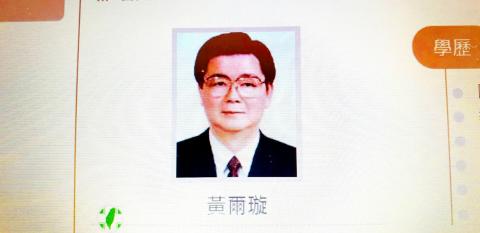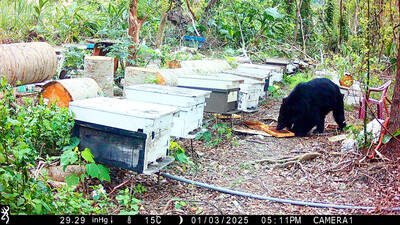The Ministry of Education and intelligence agencies were behind Huang Erh-hsuan’s (黃爾璇) firing from Soochow University in 1983, the Executive Yuan’s Transitional Justice Commission has said, deeming the incident a case of political persecution.
Huang was an associate professor of political science at the university. He was also a founding member of the Democratic Progressive Party (DPP) and served as a Presidential Office adviser. He passed away on Feb. 9.
The commission on March 13 launched an investigation into Huang’s firing.

Photo: Screen grab from the Internet
It contacted Huang’s daughter to obtain his notes, diaries, manuscripts and articles to gain a better understanding of the social atmosphere at the time of his firing, the commission said, adding that it interviewed Huang’s former colleagues, friends and relatives to ascertain if there is any information that needs to made public.
In light of the Huang family’s long-standing belief that his sacking was caused by political interference, the commission said it also combed through political archives looking for evidence of Huang being monitored by the then-Chinese Nationalist Party (KMT) regime.
A direct link has been established between Huang’s firing and interference by the KMT and intelligence agencies, which had determined that Huang’s “inciting remarks and actions had incited students,” the commission’s preliminary findings showed.
The commission found that then-university president Duan Mu-kai (端木愷) had written a letter to Huang in June 1983, saying that the school was planning to reduce the number of classes and faculty at its Department of Political Science, citing graduates’ difficulty in finding jobs and low enrollment rates.
Huang was subsequently fired from the university.
Colleges and universities at the time were mostly infiltrated by investigation bureau agents, military education officers, and KMT and China Youth Corps members, the commission said, citing the interviewees.
The university reduced the number of classes at the department from two to one following Huang’s firing, but raised it back to two soon afterward, which aroused suspicion, the commission said.
The incident implicates the ministry, as universities need its permission to change the number of classes, it added.
Evidence points at the ministry and intelligence agencies as the masterminds behind Huang’s sacking, but the decision was carried out by the university, the commission said, adding that its conclusion is backed by political archives.
The commission said the then-KMT regime stepped up its monitoring of public and private colleges, and integrated its political, party and military systems on campuses after a student movement was galvanized by the 1971-1972 Baodiao movement to defend the nation’s sovereignty claim over the disputed Diaoyutai Islands (釣魚台).
In 1971, the then-KMT regime established a mechanism called the “Chun Feng Briefing” (春風會報), which was tasked with decisionmaking, collecting intelligence on “campus security,” and overseeing the so-called campus stability groups formed by faculty and investigation bureau agents to eliminate “threats” on campus, the commission said.
It said its investigation has found that Huang’s firing was favored by the Chun Feng Briefing, citing records of meetings from the first half of 1983, when Huang was reported by “whistle-blowers” as having made improper comments and was branded an “extremist” for allegedly trying to incite students and participating in “inappropriate activities.”
Records show that the authorities were worried that the university’s development might be hindered if Huang ran for department head and endorsed candidates vying for the leadership of students’ associations, the commission said.
The then-KMT regime’s crackdown on Huang did not cease after his firing, the commission said, adding that the party contacted other schools to prevent Huang from taking up teaching positions at them.
There might be other victims of political interference by the Chun Feng Briefing and campus stability groups, the commission said, adding that it would investigate the matter further to reveal the truth behind on-campus monitoring activities and discover any human rights violations.
The commission called on the KMT to confront its past human rights violations and infringements of constitutional democracy, and refrain from impeding society’s effort to seek reconciliation.

SHIPS, TRAINS AND AUTOMOBILES: The ministry has announced changes to varied transportation industries taking effect soon, with a number of effects for passengers Beginning next month, the post office is canceling signature upon delivery and written inquiry services for international registered small packets in accordance with the new policy of the Universal Postal Union, the Ministry of Transportation and Communications said yesterday. The new policy does not apply to packets that are to be delivered to China, the ministry said. Senders of international registered small packets would receive a NT$10 rebate on postage if the packets are sent from Jan. 1 to March 31, it added. The ministry said that three other policies are also scheduled to take effect next month. International cruise ship operators

NUMBERS IMBALANCE: More than 4 million Taiwanese have visited China this year, while only about half a million Chinese have visited here Beijing has yet to respond to Taiwan’s requests for negotiation over matters related to the recovery of cross-strait tourism, the Tourism Administration said yesterday. Taiwan’s tourism authority issued the statement after Chinese-language daily the China Times reported yesterday that the government’s policy of banning group tours to China does not stop Taiwanese from visiting the country. As of October, more than 4.2 million had traveled to China this year, exceeding last year. Beijing estimated the number of Taiwanese tourists in China could reach 4.5 million this year. By contrast, only 500,000 Chinese tourists are expected in Taiwan, the report said. The report

The Forestry and Nature Conservation Agency yesterday launched a gift box to market honey “certified by a Formosan black bear” in appreciation of a beekeeper’s amicable interaction with a honey-thieving bear. Beekeeper Chih Ming-chen (池明鎮) in January inspected his bee farm in Hualien County’s Jhuosi Township (卓溪) and found that more than 20 beehives had been destroyed and many hives were eaten, with bear droppings and paw prints near the destroyed hives, the agency said. Chih returned to the farm to move the remaining beehives away that evening when he encountered a Formosan black bear only 20m away, the agency said. The bear

Chinese embassy staffers attempted to interrupt an award ceremony of an international tea competition in France when the organizer introduced Taiwan and displayed the Republic of China flag, a Taiwanese tea farmer said in an interview published today. Hsieh Chung-lin (謝忠霖), chief executive of Juxin Tea Factory from Taichung's Lishan (梨山) area, on Dec. 2 attended the Teas of the World International Contest held at the Peruvian embassy in Paris. Hsieh was awarded a special prize for his Huagang Snow Source Tea by the nonprofit Agency for the Valorization of Agricultural Products (AVPA). During the ceremony, two Chinese embassy staffers in attendance